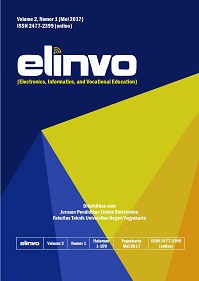THE DESIGN AND IMPLEMENTATION OF AN EDUCATIONAL MULTIMEDIA INTERACTIVE OPERATION SYSTEM USING LECTORA INSPIRE
DOI:
https://doi.org/10.21831/elinvo.v2i1.16633Keywords:
ADDIE model, learning tool.Abstract
References
Dick, W., & Carey, L. 1996. The systematic design of instruction (4th ed.). New York: Harper Collins College Publishers
Faruk, Alfensi. 2014. Development of Interactive Learning Media Based Lectora Inspire in Discrete Method Course. Proceeding of International Conference On Research Implementation and Education of Mathematics and Sciences. ISBN: 9780979-99314-8-1
Grinager, Heather. 2006. How Education Technology Leads to Improved Student Achievement. National Conference of State Legislatures. Education Issues.
Masino, Serena and Zarazua, Miguel Nino. 2016. What Works to Improve The Quality of Student Learning in Developing Countries?. International Journal of Educational Development. Volumen 48 Pages 53-65.
Martin, Florence and Ertzberger, Jeffrey. 2013. Here and Now Mobile Learning : An Experimental Study on The Use of Mobile Technology. Journal Computers and Education Pages 76-85.
Moradmand, Nasrin; Datta, Amitava and Oakley, Grace. 2014.The Design and Implementation of an Educational Multimedia Mathematics Software: Using ADDIE to Guide Instructional System Design .The Journal of Applied Instructional Design, Vol 4 Issue 1 October. http://jaidpub.org ISSN:2160-5289
Offer, J., & Bos, B. 2009. The design and application of technology-based courses in the mathematics classroom. Computers & Education, 53(4), 11331137
Wibawa, Setya Chendra., & Beth Clark.2014. The Value of Student Creative e-Portfolio Using Android Cellphone Cameras for Inventive Beauty Photography. International Conference on Advanes in Education Technology (ICAET), ISBN: 978-94-62520-44-8, ISSN:2352-5398, http://www.atlantis-press.com/php/download_paper.php?id=16161
Wibawa, Setya Chendra, Schulte, Svan, 2015. Beauty Media Learning using Android Mobile Phone. http://ijirae.com/volume-2-issue-11 page 20-26
Downloads
How to Cite
Issue
Section
Citation Check
License
The article published in ELINVO became ELINVO's right in publication.
This work by ELINVO is licensed under a Creative Commons Attribution-NonCommercial 4.0 International License.







